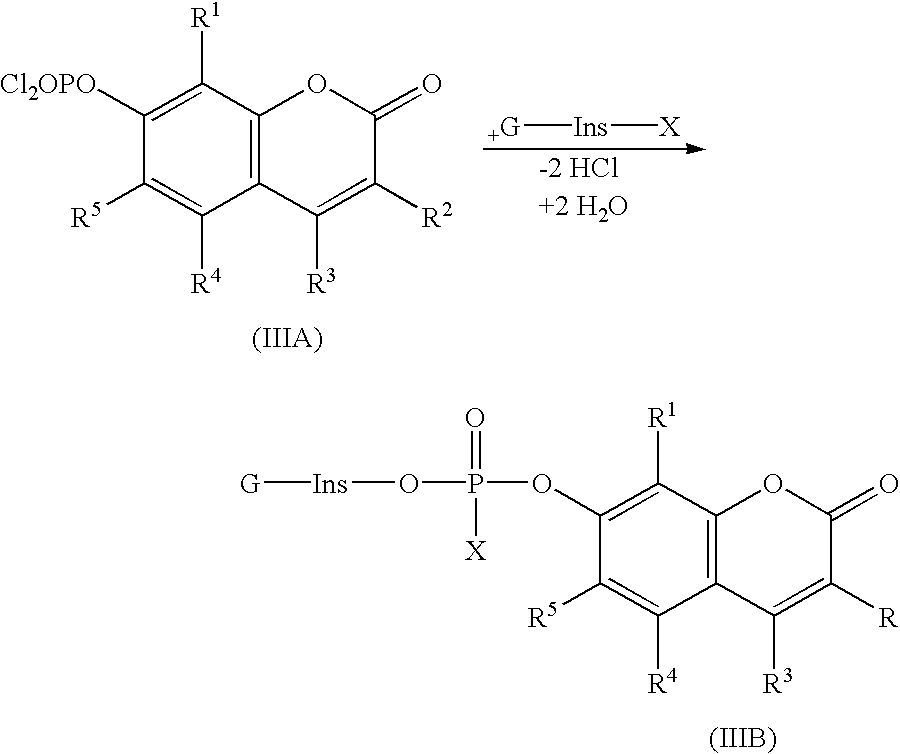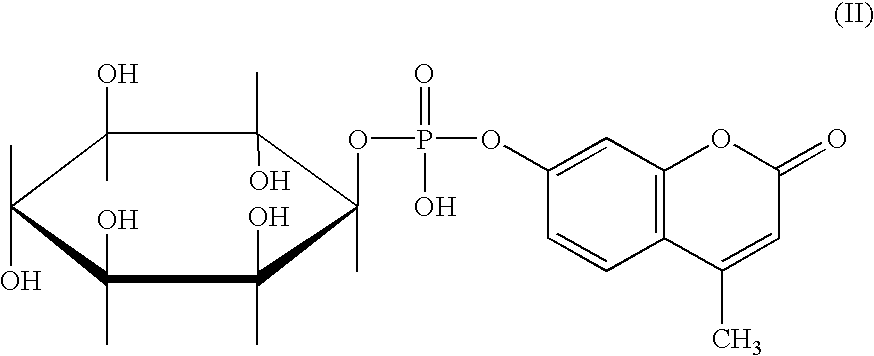Potentially fluorogenic compounds
a technology of fluorogenic compounds and compounds, applied in the field of potentially fluorogenic compounds, can solve the problems of discontinuous method, laborious and time-consuming,
- Summary
- Abstract
- Description
- Claims
- Application Information
AI Technical Summary
Benefits of technology
Problems solved by technology
Method used
Image
Examples
example 1
Preparation of the Lithium and N-methylmorpholine Salt of 4-Methylumbelliferyl Myo-inositol-1-phosphate
2,3:5,6-Di-isopropylidene-4-(4-methoxy-tetrahydropyran-4-yl-)-myo-inositol (cf. M. S. Shashidar et al., Chem. Phys. Lipids 60 (1991), 101) was prepared as described in this reference.
Crude 4-methylumbelliferyl-dichlorophosphate (containing approximately one equivalent of pyridine hydrochloride) was prepared by the method described for 1-acetyl-5-bromo-4-chloro-indoxyl-3-dichlorophosphate by J. P. Horwitz et al. in J. Med. Chem. 13 (1970), 1024.
Step 1: Preparation of the Pyridine Salt of 4-methylumbelliferyl[2,3: 5,6-di-isopropylidene-4-(4-methoxytetrahydropyran-4-yl)-myo-inositol]-1-phosphate
Crude 4-methylumbelliferyl-dichlorophosphate (1.80 g, corresponding to 1.28 g, 4.37 mMol, pure substance) was suspended under nitrogen in dry pyridine (13 ml) and 2,3:5,6-Di-isopropylidene-4-(4-methoxy-tetrahydropyran-4-yl-)-myo-inositol (0.93 g, 2.48 mMol) was added after 20 minutes. The mixtu...
example 2
Stability of the Fluorogenic Substrate in Buffer Solutions at Different pH Values
In this example, a Perkin-Elmer Lambda 15 Spectrophotometer was used for the experiments which were conducted at ambient temperature (about 25.degree. C.).
The stability of the new fluorogenic substrate MeU-phos inositol was investigated in 3 ml cuvettes in buffer solutions containing 0.1% bovine serum albumin (BSA) under various pH conditions (0.1 M sodium citrate buffers of pH 5 and 6; 0.1 M Tris / HCl buffers of pH 7, 8 and 8.5) followed by spectrophotometric detection of 4-methyl-umbelliferone at 360 nm either by continuous measurement or (for pH values <8) by discontinuous measurement (rising the pH to 9.5) as described in example 3 below.
The results (c.f. Table 1) show that the fluorogen was liberated under the conditions of enzyme assay when the pH was alkaline. This non-enzymatic hydrolysis was linear if plotted versus time and substrate concentration, and rose markedly with rising pH values.
These ...
example 3
Colorimetric Assay of PI-PLC Using MeU-phos-inositol
In this example, a Perkin-Elmer Lambda 15 Spectrophotometer was used for the experiments which were conducted at ambient temperature (about 25.degree. C.).
The procedure for the detection of PI-PLC was as follows:
MeU-phos-inositol was dissolved in 25 ml of 0.1 M sodium citrate buffer of pH 6.0 containing 0.1% of bovine serum albumin (BSA).
An aliquot from a stock solution of PI-PLC (Boehringer Mannheim #1143 069; specific activity 600 U / mg corresponding to 10.002 kat / kg, 5U / 100 .mu.l solution, corresponding to 8.33 .mu.g / 100 .mu.l) was added.
After defined periods of time 3 ml of the solution were transferred to a cuvette.
The enzymatically liberated 4-methylumbelliferone was converted into the anionic form by addition of 0.05 ml of 1 N sodium hydroxide solution (pH rose to approximately 9.5). The photometer readings at 360 nm were noted immediately for different enzyme concentrations.
FIG. 1 shows the absorbance as a function of time f...
PUM
 Login to View More
Login to View More Abstract
Description
Claims
Application Information
 Login to View More
Login to View More - R&D
- Intellectual Property
- Life Sciences
- Materials
- Tech Scout
- Unparalleled Data Quality
- Higher Quality Content
- 60% Fewer Hallucinations
Browse by: Latest US Patents, China's latest patents, Technical Efficacy Thesaurus, Application Domain, Technology Topic, Popular Technical Reports.
© 2025 PatSnap. All rights reserved.Legal|Privacy policy|Modern Slavery Act Transparency Statement|Sitemap|About US| Contact US: help@patsnap.com



